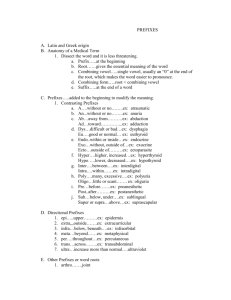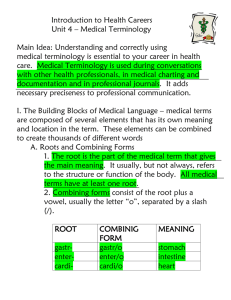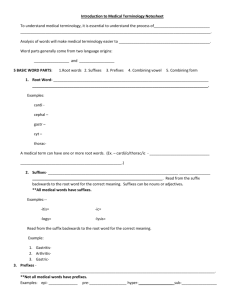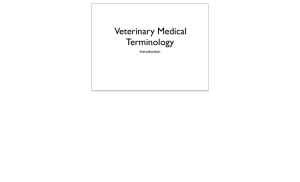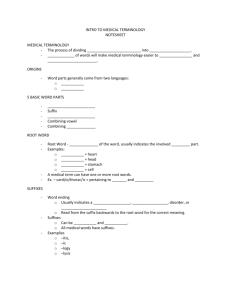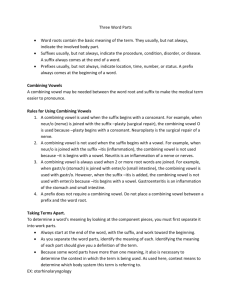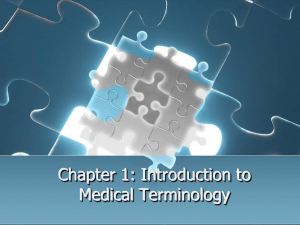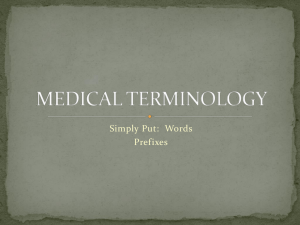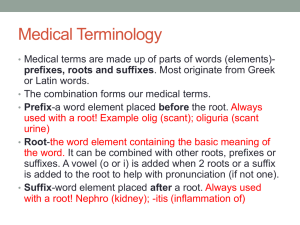Intro To vet Studies
advertisement
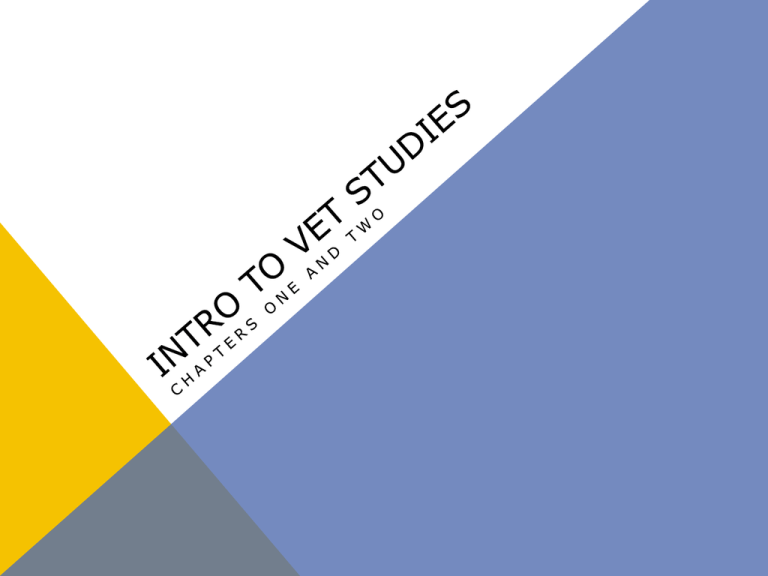
OBJECTIVES ID and recognize the parts of a medical term Define commonly used parts of medical term Analyze and understand basic medical terms Practice pronunciation of medical terms WARM UP Any guesses? Pneumonoultramicroscopicsilicovolcanoconiosis BIG IDEA QUESTION What are the major parts of a term? VET TERMINOLOGY • Every word has main parts • Like a sandwich! • • • • • • Parts of the “sandwich” Prefix- bread Root- meat Combining Vowel – lettuce Combining form – tomato Suffix- bread VET TERMS • Used every day • Current Vocabulary • Based on terms of Greek and Latin origin • Or Eponyms: words formed from a person’s name • Better understanding of Latin and Greek = better understanding of medical terminology PREFIXES Found at the beginning Indicates a #, location, time, or status Two types Contrasting Directional Example: Ab- means away from ACTIVITY 1 sheet of lined paper Fold it in half (long like a hot dog) Put the prefixes on one half, definition on the other Studying graphic organizer Perform this exercise for both types of prefixes IS THERE A PREFIX? Pneumonoultramicroscopicsilicovolcanoconiosis ROOT WORDS Give essential meaning to the word Is there a root? Pneumonoultramicroscopicsilicovolcanoconiosis COMBINING VOWEL Normally single Usually an o I and E also used Added to root word to make it easier to pronounce When 2+ root words are joined Not used when the suffix begins with a vowel Example: Gastro/o + enter/o = gasteroenteritis How many? Pneumonoultramicroscopicsilicovolcanoconiosis COMBINING FORMS Root word + a combining vowel Usually describes part of the body New words are created when prefixes + combining forms and suffixes Examples Panleukopenia Pan: prefix meaning all Leuk/o: combining forms meaning deficiency -penia: suffix meaning deficiency All together the word means: Deficiency of all types of white blood cells COMBINING FORMS? Pneumonoultramicroscopicsilicovolcanoconiosis SUFFIXES Attached to the end of words Modify meaning Types: “Pertaining to” Surgical Procedural Double r Conditional and Structural ANALYZING MEDICAL TERMS 1. Dissect 1.Divide the word into basic components 2. Begin at the end 1.Suffix first, then prefix, then root 2.2 root words? Divide and read left -> right 3. Anatomical Order 1.How does it occur in the body? PRACTICE TOGETHER Ovariohysterectomy Ovari/o/hyster/ectomy SUFFIX: ectomy – removal PREFIX: Ovari/o – ovary ROOT: Hysteri/o – uterus What’s it mean? Complete removal of ovaries and uterus DISSECT THE VOCABULARY Worksheet 20 words Dissect and define common medical terminology LET’S REVIEW Vocab you learned Prefix, Suffix, Combining vowel, combining form, root word Essential Question What are the major parts of a term? Think about it… What is pronunciation important? Coming up… Positional Terminology OBJECTIVES ID body planes, positional terms, directional terms, and body cavities Define terms related to body cavities ID body systems by their components ESSENTIAL QUESTION Why is positional terminology critical in veterinary medicine? LEARN-OLOGY -ology “the study of” Anatomy: student of body structure Physiology: study of body functions Pathology: study of the cause, nature and development of abnormal conditions Pathophysiology: study of changes in function caused by disease Etiology: study of disease POSITIONAL TERMS Important for accurately and concisely describing body locations and relationships of structures In/out, up/down, etc Not specific ACTIVITY: DIRECTIONAL DE-CODER 1 sheet of lined paper Fold is in half (like a hotdog) Put the directional words on one half , definition on the other half Table 2-1 in your book POSITIONAL PLANES ACTIVITY VET DENTISTRY POSITIONAL TERMS Rising trend in vet care Teeth surfaces are identified by the area it is near Lingual, Palatal, Buccal, Vestibular, Occlusal, Labial, Contact ( mesial and distal) BODY CAVITIES Hole/hollow space that contains organs Cranial, Spinal, Thoracic/chest, Abdominial/ peritoneal, Pelvic Regional Terms Abdomen, Thorax, Groin/ inguinal MEMBRANES: HOLD IT ALL TOGETHER Thin layer of tissue Cover a surface, line a cavity, divide space or organ Membranes to remember Peritoneum Parietal, Visceral (Peritonitis= inflammation of the…) Umbilicus/Navel (belly button) umbilical chord enters the body Mesentery suspends the intestines in abdominal cavity holds blood supply POSITIONS USED IN EXAMS Recumbent: lying down Types: Dorsal: on the back Ventral (sternal): on your belly Left Lateral: on left side Right Lateral: on your right side Prone: lying ventral or sternal Supine: lying on your back MOVEMENT Adduction: movement toward midline Abduction: movement away from the midline JOINT MOVEMENT Flexion: close joint Extension: straightening of the joint hyper: flex or extend too far Supination: rotate to palm up Pronation: palm turn down Rotation: circular movement around an axis ACTIVITY: PRACTICE MOVEMENTS CELLS AND ACTIVITY Cytology: study of cells Draw and label your cell diagram as a review Use your book to describe what each organelle does GLANDS: IMPORTANT CELL TYPES Specialized cell that secrete material used else where in the body Types: Endocrine: secrete directly into the blood stream Exocrine: secrete into the duct system TISSUE TYPES Epithelial: Covers in and external body structures Types: Squamous, Cubodial, Columnar, Stratified Mesothelium: forms the lining of serious membranes Connective Tissue Types Loose, dense, cartilage Muscle: contains cell material that can relax and contract Types Skeletal, smooth, cardiac Nervous: can react to stimuli and conduct electric impulses ACTIVITY BREAK Use your book On a separate sheet of paper Represent the different types of tissue Epithelial 4 types Connective 4 types Muscle 3 types THINK ABOUT THE BIG PICTURE! Cells make up tissues Tissues make up structures Structures make up organs Organs perform functions Functions required for survival REVIEW Vocab you learned Endocrine, Exocrine, Epithelial, Connective, Nervous, Muscle, Prone, Supine, Adduction, Abduction, Flexion, Extension Essential Question Why is positional terminology important in vet medicine? ACTIVITIES FOR GRADING Chapter Review one and two Foldables : prefixes and table 2-1 Cell representation Types of Tissues Medical Terminology Dissection
